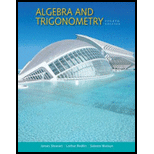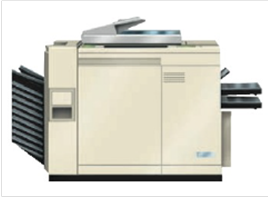
Concept explainers
Renting versus buying a photocopier A certain office can purchase a photocopier for $5800 with a maintenance fee of $25 a month. On the other hand, they can rent the photocopier for $95 a month (including maintenance). If they purchase a photocopier, each copy would cost 3¢; if they rent, the copy is 6¢ per copy. The office estimates that they make 8000 copies a month.
(a) Find a formula for the cost
(b) Find a formula for the cost
(c) Make a table of the cost of each method for 1 year to 6 years of use, in 1-year increments.
(d) After how many moths of use would the cost be the same for each method?

(a)
To Find:
A formula for the cost of purchasing a photocopier for n months.
Answer to Problem 1P
Solution:
Explanation of Solution
The cost of the photocopier is $5800.
The maintenance cost per month is $25.
When the photocopier is purchased, the cost per copy is 3¢.
The office makes 8000 copies per month.
Then, the cost of 8000 copies is
Because, $1=100¢.
We need to find a formula for purchasing and using the photocopier for
The total cost for purchasing and using a photocopier can be obtained by adding the cost of photocopier, maintenance cost and the cost of the copies.
Therefore,
Hence, the formula for purchasing and using a photocopier is
(b)
To Find:
A formula for the cost of renting a photocopier.
Answer to Problem 1P
Solution:
Explanation of Solution
The cost for rent and maintenance of the photocopier per month is $95.
When the office rent a photocopier, the cost per copy is 6¢.
The office makes 8000 copies per month.
Then, the cost of 8000 copies is
We need to find a formula for renting and using the photocopier for
Therefore,
Hence, the formula for purchasing and using a photocopier is
(c)
To Find:
A table for the cost of each methods.
Answer to Problem 1P
Solution:
| n | Purchase (in dollars) |
Rent (in dollars) |
| 12 | 8980 | 6900 |
| 24 | 12160 | 13800 |
| 36 | 15340 | 20700 |
| 48 | 18520 | 27600 |
| 60 | 21700 | 34500 |
| 72 | 24880 | 41400 |
Explanation of Solution
The formula for purchasing and using a photocopier is
Substitute
Then,
Substitute
Then,
Substitute
Then,
Substitute
Then,
Substitute
Then,
Substitute
Then,
The formula for renting and using a photocopier is
Substitute
Then,
Substitute
Then,
Substitute
Then,
Substitute
Then,
Substitute
Then,
Substitute
Then,
(d)
To Find:
A formula for the cost of renting a photocopier.
Answer to Problem 1P
Solution:
After 19 months the cost is same for each method.
Explanation of Solution
The formula for purchasing and using a photocopier is
The formula for renting and using a photocopier is
It is given that the cost becomes same for both the methods.
Therefore,
Now,
Then,
Hence,
Hence, after 19 months the cost is same for each method.
Want to see more full solutions like this?
Chapter P Solutions
Algebra and Trigonometry (MindTap Course List)
- In simplest way, For each quadratic relation, find the zeros and the maximum or minimum. a) y = x 2 + 16 x + 39 b) y = 5 x2 - 50 x - 120arrow_forwardIn simplest terms and step by step Write each quadratic relation in standard form, then fi nd the zeros. y = - 4( x + 6)2 + 36arrow_forwardIn simplest terms and step by step For each quadratic relation, find the zeros and the maximum or minimum. 1) y = - 2 x2 - 28 x + 64 2) y = 6 x2 + 36 x - 42arrow_forward
- Write each relation in standard form a)y = 5(x + 10)2 + 7 b)y = 9(x - 8)2 - 4arrow_forwardIn simplest form and step by step Write the quadratic relation in standard form, then fi nd the zeros. y = 3(x - 1)2 - 147arrow_forwardStep by step instructions The path of a soccer ball can be modelled by the relation h = - 0.1 d 2 + 0.5 d + 0.6, where h is the ball’s height and d is the horizontal distance from the kicker. a) Find the zeros of the relation.arrow_forward
- Algebra & Trigonometry with Analytic GeometryAlgebraISBN:9781133382119Author:SwokowskiPublisher:Cengage
 Glencoe Algebra 1, Student Edition, 9780079039897...AlgebraISBN:9780079039897Author:CarterPublisher:McGraw Hill
Glencoe Algebra 1, Student Edition, 9780079039897...AlgebraISBN:9780079039897Author:CarterPublisher:McGraw Hill Holt Mcdougal Larson Pre-algebra: Student Edition...AlgebraISBN:9780547587776Author:HOLT MCDOUGALPublisher:HOLT MCDOUGAL
Holt Mcdougal Larson Pre-algebra: Student Edition...AlgebraISBN:9780547587776Author:HOLT MCDOUGALPublisher:HOLT MCDOUGAL  Elementary AlgebraAlgebraISBN:9780998625713Author:Lynn Marecek, MaryAnne Anthony-SmithPublisher:OpenStax - Rice University
Elementary AlgebraAlgebraISBN:9780998625713Author:Lynn Marecek, MaryAnne Anthony-SmithPublisher:OpenStax - Rice University Algebra: Structure And Method, Book 1AlgebraISBN:9780395977224Author:Richard G. Brown, Mary P. Dolciani, Robert H. Sorgenfrey, William L. ColePublisher:McDougal Littell
Algebra: Structure And Method, Book 1AlgebraISBN:9780395977224Author:Richard G. Brown, Mary P. Dolciani, Robert H. Sorgenfrey, William L. ColePublisher:McDougal Littell





